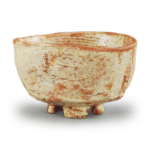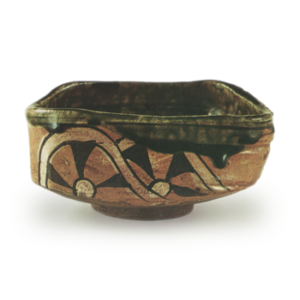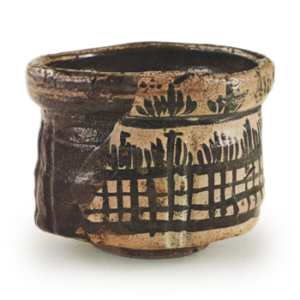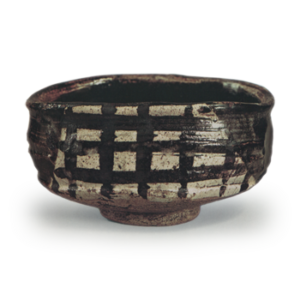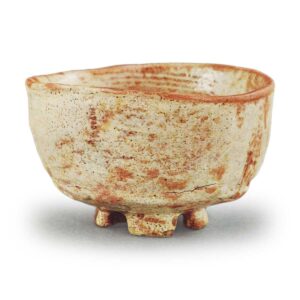
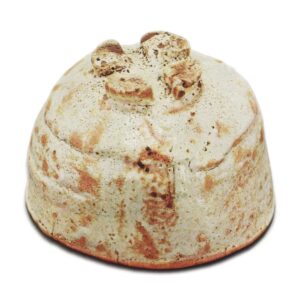
Collection: Fujita Museum of Art
Height: 8.2 – 8.9 cm
Diameter: 13.8 – 14.5 cm
Outer diameter of foot: 5.7 – 6.5 cm
Height: 1.1 cm
The name Asahi (morning sun) was given to this piece because of the pleasant light pink color of the morning sky as it begins to dawn through a thin white mist. However, this bowl is a rather unusual piece of Shino ware, with a slightly different feel to ordinary Shino ware.
First of all, the sturdy cross-shaped foot ring is unusual. In particular, the cross is cut thickly, giving the appearance of four large feet. The body of the vessel, supported by this large foot ring, is also wide and full, and the overall shape is reminiscent of the way the foot ring is made in Korean tea bowls.
The general method of forming is to roughly shape the piece on the potter’s wheel, and then finish it by smoothing the surface evenly with the fingertips. Unlike normal Shino ware, the potter rarely uses a tool, and the dent around the waist is also made by half-crushing the surface with the fingertips. There are no visible marks from the spatula on the rim’s inflection or twist. Therefore, the whole surface has a strong handmade feel.
The entire piece is covered in glaze, so the only places where the clay can be seen are the slightly raised part of the foot ring and the four marks on the inside of the rim, and even here the influence of the Korean tea bowl can be seen.
The glaze layer is uneven in thickness, with many thin areas, especially on the outside, where the iron content of the clay is unevenly colored a light pink, giving the impression of the purity and warmth of the morning sun.
In the foreground, a pagoda stands behind a spider, and the top of the pagoda and the nine-tiered pagoda finial are gently hidden in the morning mist. In this simple composition, the empty space is very wide, and the red glow of the eastern sky gradually appears in this expanse. In addition, there is a single horizontal line of coarse gray brush marks running around the inside and outside of the bowl, close to the rim. Although these brush marks are regular and evenly spaced, they look like the distant fluttering of thin clouds in the morning sun. This is a wonderful natural effect that the potter could never have anticipated.
The glaze layer gradually thickens from the side to the bottom, creating a beautiful milky white glossy surface. And, running across the underside of the glaze are three or four brush strokes of grayish black, with four more clearly dotted around them. While the outer design has a tranquil feel, the inside has a light brushwork and a lively tone. It can be said that this kind of interesting effect was only achieved by hiding the superior technique within.
There is another Shino tea bowl of the same type as this one, the famous “Iwahashi” tea bowl, which was formerly owned by the late Mr. Kinya Nagao. The shape is almost the same, and the painting is of a single pagoda with a light touch, and it is a bowl with a very similar style, but in terms of the color of the glaze, the Asahi is a light pink, while the Iwahashi is a little greyish, like Nezumi Shino ware.
The history of the bowl is unknown until it entered the Fujita family.
The author of the inscription on the box is also unknown.

